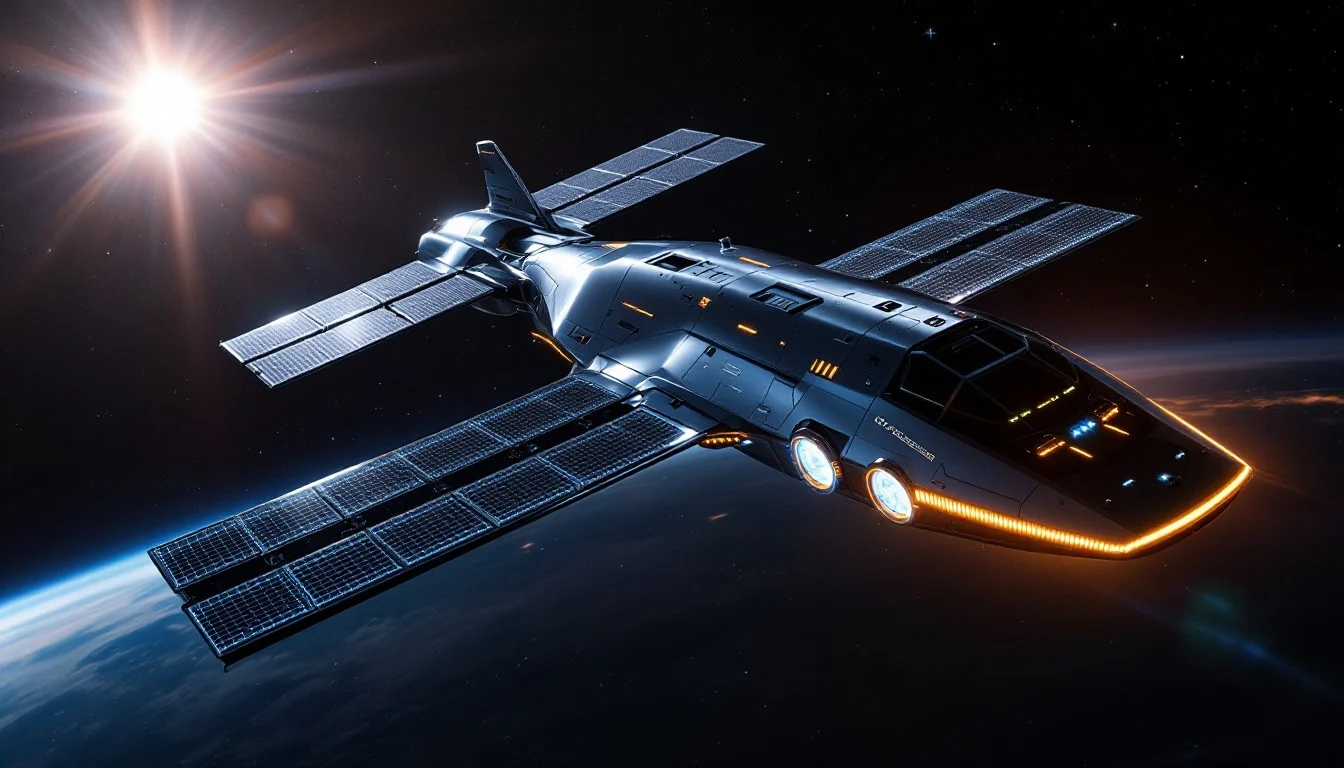Space has never been more exciting—and the pace of innovation is only accelerating. In the last decade, companies like SpaceX (with Starlink) and Blue Origin have changed the game, turning science fiction into daily headlines. But with these giants blazing trails, everyone’s asking: What comes next?
Today, we stand at the edge of the most thrilling era in space technology since the Moon landing. Mega-constellations, reusable rockets, quantum communications, space mining, and lunar colonies are no longer dreams but plans in motion. From Silicon Valley startups to worldwide government collaborations, a new chapter is unfolding. Let’s lift off and explore what the future holds.
The Legacy of Starlink and Blue Origin: A Quick Recap
Before we launch into tomorrow, let’s remember why Starlink and Blue Origin are such transformative names.
- Starlink: SpaceX’s global satellite internet project, connecting even the remotest corners of Earth with high-speed internet. Its deployment shows how space tech can directly impact everyday lives—helping everything from homeschooling to disaster response.
- Blue Origin: Founded by Jeff Bezos, Blue Origin champions reusable rockets and accessible space travel. Projects like New Glenn point to a sustainable, cost-effective future—and even plans for Moon and Mars missions.
Both companies have shattered old barriers. Now, their wake is creating new opportunities for technology, business, and adventure.
The New Space Race: What’s Fueling the Boom?
No longer is space the playground of just two or three superpowers. Lower launch costs, major private investments, and open international competition have created a modern gold rush for orbit and beyond. What’s at the core of this explosion?
- Cheaper, More Reliable Launches: Reusable rockets mean massive savings and faster turnaround. What was once a $100 million launch is now $10 million or less—and that number keeps dropping.
- Miniaturization of Technology: Small satellites, or “smallsats,” are revolutionizing the sector. They’re less expensive, easier to launch in clusters, and can perform vital tasks like Earth observation, communication, and climate monitoring.
- Rapid Innovation Cycles: Advanced manufacturing and 3D printing let companies design and test new tech in months, not years.
- Cross-Industry Collaboration: Space is attracting AI pioneers, biotech leaders, clean energy innovators, and more, fueling powerful partnerships.
H2: Beyond Starlink—The Next Wave of Satellite Revolution
H3: Mega-Constellations Connecting the Planet
Starlink is only the beginning. Companies like Amazon (Project Kuiper), OneWeb, and China’s Guowang aim to launch their own satellite mega-constellations. These networks will beam high-speed, ultra-secure internet to every point on the globe—with laser communication links, quantum encryption, and machine learning-driven collision avoidance.
The business impact is staggering. Economists predict the global space economy could reach $1.8 trillion by 2035, with advanced broadband and data services leading the charge.
H3: Earth Observation Gets Smarter
Satellites are no longer just orbiting cameras—they’re “diagnostic systems” for our planet. Next-gen satellites use hyperspectral imaging combined with AI, offering real-time data on wildfires, pollution spills, crop diseases, and more. This revolution drives smarter agriculture, disaster response, urban planning, and climate change mitigation.
H3: Interplanetary Internet and Navigation
The next leap? Creating internet and GPS networks for the Moon and Mars. Starlink-style “interplanetary constellations” will support future lunar bases, Mars habitats, and deep-space missions. Reliable communication and navigation are essential for safer, more productive exploration beyond Earth.
H2: Rockets That Rewrite the Rulebook
H3: Reusability and Rapid Turnaround
Blue Origin’s New Glenn rocket takes the baton from SpaceX’s Falcon 9, aiming for up to 25 flights per booster. This focus on reusable launch vehicles slashes costs, reduces waste, and enables more frequent missions—from launching constellations to Mars cargo drops.
H3: Next-Gen Propulsion
Electric, nuclear, and green propulsion systems are redefining what’s possible:
- Electric and Ion Thrusters: Highly efficient, perfect for small satellites and deep-space probes.
- Nuclear Propulsion: Promises faster travel to Mars and beyond, thanks to higher thrust and fuel efficiency.
- Eco-Friendly Fuels: Green fuels like hydrogen and water-based systems minimize toxic byproducts—to protect low Earth orbit and the wider environment.
H3: Private Launchers Worldwide
It’s not just SpaceX and Blue Origin. Startups in Europe, India, and Asia are entering the launch business with reusable, modular, and cost-saving designs. Indian companies like Agnikul and Skyroot are racing toward commercial launches, benefiting from 3D-printed engines and private launchpads.
H2: Human Spaceflight and the Commercial Frontier
H3: Space Tourism Opens the Skies
With fares dropping and safety records improving, suborbital and orbital tourism is becoming a reality. Virgin Galactic, Blue Origin, and even emerging startups want to send passengers beyond the Kármán line—first for joyrides, then for hotel stays, research missions, and more.
H3: Lunar and Martian Ambitions
NASA and its partners target the Moon’s south pole for the next giant leap, with Blue Origin’s lunar lander and Artemis project missions. The long-term vision? Permanent outposts, mining water ice for rocket fuel, and using lunar resources to push deeper into space.
Mars is next. Elon Musk’s plans for Starship-powered colonization are well known, but they’re joined by other international efforts aiming to send humans and robotic colonies to the Red Planet—supported by robust supply chains, AI, and 3D printing on site.
H3: Advanced Habitats and Life Support
Today’s technology is driving breakthroughs in habitats, spacesuits, and recycling systems. Innovations include next-gen “BioSuits” for mobility, artificial gravity modules, and closed-loop life support to make living on other worlds possible.
H2: Factories, Mining, and Manufacturing—In Space
H3: Microgravity Manufacturing
Zero gravity isn’t just cool—it changes how things are made. The International Space Station already produces optical fibers, pharmaceuticals, and high-purity materials not possible on Earth. The future? Fully autonomous manufacturing satellites, printing everything from rocket parts to replacement organs.
H3: Space Mining Takes Shape
Asteroids and the Moon contain water (vital for life and rocket fuel) and rare metals like platinum. Mining these resources could support sustainable bases and export valuable materials to Earth—opening entirely new space business models.
H3: Toward Space-Based Solar Power
Massive orbital solar power stations may soon beam clean energy to Earth, offering a new frontier in renewable energy. As launch and manufacturing costs drop, this once-futuristic idea edges closer to reality.
H2: AI, Quantum Tech, and the New Digital Space Age
H3: Artificial Intelligence Everywhere
AI is now essential for operating satellites, processing data, and guiding autonomous spacecraft. From mission planning to real-time hazard response, machine learning and digital twins enhance every step of the journey.
H3: Quantum Communications in Orbit
Quantum encryption promises unbreakable data security. New satellites are being fitted with quantum key distribution hardware—keeping government, banking, and personal data safe from hackers (even the quantum kind).
H3: Space Debris and Sustainability
As space fills up, managing “space junk” becomes crucial. Next-gen satellites include collision-avoidance systems and on-orbit servicing robots to upgrade, repair, or deorbit aging satellites. Eco-friendly propulsion and debris-reduction policies are gaining traction to ensure a sustainable space environment for future generations.
H2: Game-Changers—Startups, Innovators, and Global Voices
H3: Startups Leading the Charge
Around the world, startups are innovating in every facet of the space sector. Some highlights:
- InspeCity (India): Green propulsion and autonomous satellite servicing.
- Pixxel (India): Hyperspectral Earth observation satellites for agriculture and climate science.
- ThrustMe (France): Electric iodine-based satellite thrusters.
- Galactiv (Europe): Modular spacecraft servicing platforms.
- Farmdar: Satellite crop monitoring using AI.
H3: Global Collaboration & Policy
Countries now cooperate on shared missions, data standards, and sustainable practices. Whether it’s a lunar base, space traffic management, or debris mitigation, global teamwork will shape the long-term success of the space tech boom.
H2: What’s On the Horizon—the Next Decade
- Human lunar bases within the 2030s
- Mars sample return and first human flybys
- Mass-market internet from mega-constellations
- Microgravity factories producing medical breakthroughs
- Asteroid mining ventures launching prospecting missions
- Advancements in climate monitoring, communications, and disaster readiness
The possibilities for science, business, and even everyday life are expanding at light speed.
Conclusion: Get Ready for Lift Off
The space tech boom is only getting started. Thanks to Starlink, Blue Origin, and a sweeping wave of new innovators worldwide, we’re entering an era where space is open to more people, ideas, and industries than ever before.
Whether you’re a tech enthusiast, investor, entrepreneur, or dreamer, now is the time to get inspired—or get involved. The cosmos beckons, and your next big opportunity might just be orbiting above your head.
Are you ready to join the space tech revolution? Subscribe for the latest updates, and let’s explore the future together!






